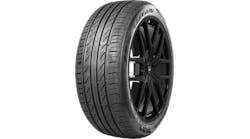Nira Dynamics and Audi are getting ready to introduce an indirect TPMS that meets U.S. government guidelines
How close is anyone to producing an indirect tire pressure monitoring system (TPMS) that meets National Highway Traffic Safety Administration guidelines? Is this year close enough?
While the direct systems monitor individual tire pressure via sensors on each wheel, indirect systems detect underinflated tires through wheel speed sensors on anti-lock braking systems. Direct systems rely on sensors that can break; indirect system require only software.
Until an indirect TPMS can detect simultaneous deflation in all four tires, however, it will not be allowed on domestic vehicles manufactured after Aug. 31, 2007, under Federal Motor Vehicle Safety Standard 138.
At the second annual Intelligent Tire Technology conference in Dearborn, Mich., last year, Nira Dynamics AB brought a working model of its indirect system to the event.
The system, developed in association with Audi AG, impressed many at the conference, including myself and Modern Tire Dealer contributor Jacques Bajer, president of Tire Systems Engineering Inc.
An Audi representative went so far as to announce that the system would be standard on 2009 model year Audi vehicles sold in the United States. Urban Forssell, Nira’s CEO and president, agreed to elaborate on what was said and demonstrated at the event. Here are his responses to our questions.
[PAGEBREAK]
MTD: How does the NIRA/Audi indirect TPMS, called TPI, work, particularly with ABS and traction/stability control systems?
Forssell: TPI is a so-called indirect TPMS, which means it is a software-based solution inferring the status of the air pressures inside the tires using sensor signals from the ABS/ESC system. TPI does, therefore, neither use nor require any wheel electronics, special valve stems or RF (radio frequency) components, and is, therefore, the simplest possible and most robust TPMS solution you can think of.
One component of TPI analyzes changes in relative roll radii between different tires. The key observation here is that the radius of a tire which loses air decreases whereby it starts to rotate faster in order to “keep up” with the other tires. By use of smart signal processing algorithms, TPI detects such phenomena developing in one, two and three tires simultaneously, and issues timely warnings to the driver.
TPI also features other components analyzing high-frequency components of the wheel speed signals stemming from different vibration modes of the wheel. These approaches are applied to each wheel separately, and by combining this with the previously mentioned radius analysis, TPI can detect under-inflation in one, two, three and four tires simultaneously.
As with any indirect TPMS, TPI requires an initial calibration or learning phase to calculate the characteristic parameter values associated with the current tires and tire pressures, which later are used to determine if the online parameter values calculated by the system in normal operating mode indicate a low pressure situation. The driver should reset the system and re-initialize calibration whenever he or she has made a change to the tires, the tire pressures or, in general, to the wheels.
MTD: What are the accuracy, reliability and durability of the system at this stage of development?
Forssell: TPI is designed to give a warning for under-inflations of 25% or more compared to the nominal pressure level, which the system learns during the calibration phase (25% is the required detection level under FMVSS 138).
The best statement regarding the reliability of the system at this point is probably that TPI (has been) in production for the Audi TT since 2006 and for the Audi A5/A4... and has received positive reactions from customers and quality assurance people alike. Further, since TPI is a software-based system using existing and well-proven components of the ABS/ESC system, in particular the wheel speed sensors, it’s optimally simple and robust. The key point here is that software doesn’t break!
[PAGEBREAK]
MTD: Does the system meet the NHTSA standard?
Forssell: Yes. This is why Audi is planning to introduce the system in the U.S.A. in mid- 2008 for a model year 2009 upper-medium class sedan vehicle.
MTD: Will the system be standard on Audi’s 2009 model year vehicles sold in the U.S., as was announced at the Intelligent Tire Technology conference?
Forssell: The statements made at the ITT conference in Dearborn... still hold. The first TPI application in an Audi vehicle will be in a model year 2009 vehicle. Subsequently, Audi will shift to this TPMS in all models.
MTD: How long does it take to tune the system for a given vehicle application?
Forssell: The system is always active when the engine is running. To achieve full performance, the driver or technician after a tire change needs to reset the system and initiate the calibration phase.
In the Audis, this is done via the menu system in the onboard computer in exactly the same way as Audi’s direct TPMS is operated today. Since Audi specifies different placard pressures for different dimensions and load conditions, the driver is instructed in the owner’s manual to reset the current direct TPMS whenever he has changed the tires and/or wants to use another placard pressure.
No further actions are required. After the reset, the system operates in a fully automatic way and learns the characteristic parameters it needs to be able to detect pressure drops during normal driving.... The required, accumulated driving time to complete the learning phase and reach nominal performance for all speed ranges can be up to one hour depending on driving cycle and driving style, but the system is active and can detect pressure drops already after a few minutes.
Ongoing pressure drops (e.g., if the driver tries to reset the system without correcting an existing fault such as a flat tire or leakage in progress) can be detected almost immediately, after one to two minutes or less depending on degree of severity.
[PAGEBREAK]
MTD: What kind of equipment and technician training do replacement tire dealers need to service the system?
Forssell: TPI requires no special equipment, tools or training to be serviced. In particular, since it doesn’t use any wheel mounted electronics, the introduction of TPI in the Audi vehicles marks a return to standard rubber valve stems.
MTD: Do you plan to adapt it to other vehicles?
Forssell: Yes. As mentioned, we are developing applications for all Audi models, and also have projects with other vehicle manufacturers. We are, thus, very optimistic about the future potential of TPI.
Cause and effect -- How the real world directly affects Nira’s indirect system
TPI, the indirect tire pressure monitoring system developed by Nira Dynamics AB, sounds good on paper. But how does it react under real-world conditions, including tire replacement and temperature changes?
Modern Tire Dealer gave Urban Forssell, Nira’s CEO and president, a list of external forces, and asked him to describe how each would affect the performance of the system.
1. Replacement tires and wheels. “In general, none! That is, the system achieves the same performance with most tire makes and models, and the rim design has no influence whatsoever.”
Forssell says the system “learns” about the new tires and/or wheels at the initial calibration phase and adapts accordingly.
2. Road surface types. “TPI is active and achieves good performance on most paved roads. If the surface is very rough, e.g., like on a rough gravel road or sometimes on roads with packed snow, the performance is degraded to avoid issuing false low pressure warnings under these circumstances.”
3. Climatic conditions/extremes of temperatures. “TPI is designed to function in all climate and weather conditions. Extensive work has been put into the development of the system to achieve good performance in low and high temperatures, in rain, in snow and so on during our product development and during the vehicle application projects we run together with our customers (the vehicle manufacturers).”
4. Vehicle types. “TPI is applicable to all kinds of vehicles, but we mainly recommend it for use in passenger cars, light trucks and SUVs, as opposed to extreme sports cars, heavy-duty pick-up trucks, and different commercial vehicles.”
He adds that TPI also works with all kinds of powertrain configurations, chassis and body styles.
However, different configurations may require special algorithms and/or special tunings that have to be developed in conjunction with the vehicle manufacturer.




